View in other NatureServe Network Field Guides
NatureServe
Montana
Utah
Wyoming
Idaho
Wisconsin
British Columbia
South Carolina
Yukon
California
New York
Black-backed Woodpecker - Picoides arcticus
State Rank Reason (see State Rank above)
Species is an uncommon resident of forested areas within Montana. Although it will use forested habitat it is particularly associated with burned areas due to the high density of snags for nesting and abundant beetle larvae within dead and dying trees. Population trend is difficult to quantify. Recent structured surveys show increased detections of the species, but populations are spatially transient as habitat suitability changes with the distribution of recent fires. Threats include fire suppression efforts that reduce burned acreage and changing fire dynamics, salvage logging of snags in burned areas, and changing climate.
General Description
Black-backed Woodpeckers are at the large end of the medium-sized woodpeckers. At 9.5 inches in length, only the flickers and Pileated Woodpeckers (
Dryocopus pileatus) are larger. Adults are similar in size and in appearance except for the yellow crown present only on the males. The back of the head, neck, back, and wings (upperparts) are all black and the chin, throat, breast and belly (underparts) are white. The sides and flanks are also white with heavy black barring. A strong white line runs below the eye from the bill to the nape (Dixon and Saab 2000). The wing primaries are barred black and white and only the outer tail feathers (rectrices) are white; otherwise the tail is black. Juvenile birds are similar in appearance but much duller overall. They have a plain black crown, with no, or nearly no, crown patch, and a washed out or buffy look to the underparts. Black-backed Woodpeckers, like Three-toed Woodpeckers (
Picoides tridactylus), have only 3 toes on each foot rather than the normal 4 toes (Dixon and Saab 2000).
The call note, a single metallic
"kyik" or
"chet" (similar to Hairy Woodpecker,
Picoides villosus) helps to detect the Black-backed Woodpecker. They also use a unique agonistic
"wet-et-ddd-eee-yaaa," or
"scream-rattle-snarl" call in association with a hunched wing-spreading display (Short 1974). Drumming is variable (fast or slow) in long, even rolls (Farrand 1983, Goggans 1989). Drumming is described as coming in 2-second bursts tapering off at the end, at intervals of 30 to 40 seconds, suggestive of Pileated Woodpeckers. They also give single raps when nervous or about to roost (Kilham 1966).
For a comprehensive review of the conservation status, habitat use, and ecology of this and other Montana bird species, please see
Marks et al. 2016, Birds of Montana.Diagnostic Characteristics
Having only three toes on each foot and, in males, having a yellow crown patch instead of red, distinguishes Black-backed Woodpeckers from all other woodpeckers except Three-toed Woodpeckers (Dixon and Saab 2000). The all-black head and back are diagnostic of Black-backed Woodpeckers. Three-toed Woodpeckers have at least some white on the back. Also, the white line under the eye is broader in Black-backed Woodpeckers; Three-toed Woodpeckers have a slimmer white line below the eye as well as another white line behind the eye. The yellow crown patch is smaller and solidly yellow in Black-backed Woodpeckers rather than larger and rather streaked in Three-toed Woodpeckers. Female Black-backed Woodpeckers have a solid black forehead and crown, which is unlike the streaked and white speckled forehead and crown of Three-toed Woodpeckers (Dixon and Saab 2000).
Species Range
Montana Range
Range Descriptions
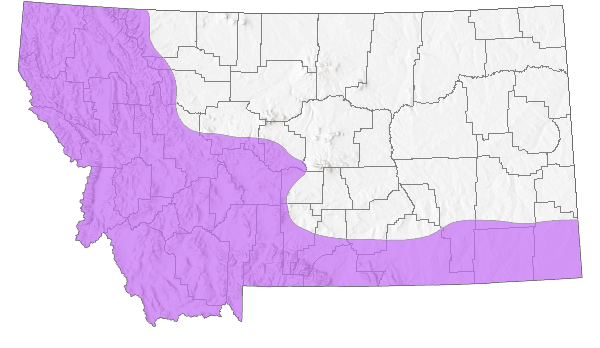
 Year-round
Year-round
Western Hemisphere Range
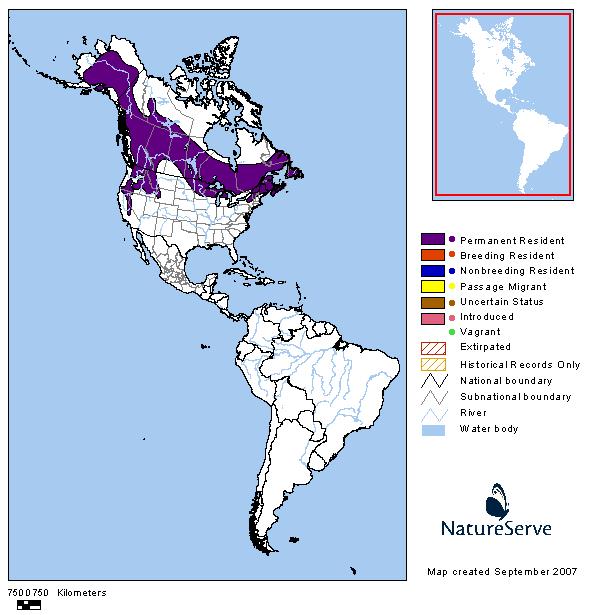
Observations in Montana Natural Heritage Program Database
Number of Observations: 1504
(Click on the following maps and charts to see full sized version)
Map Help and Descriptions
Relative Density
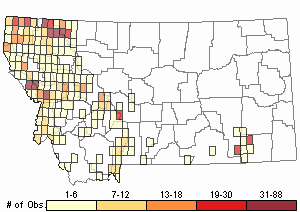
Recency
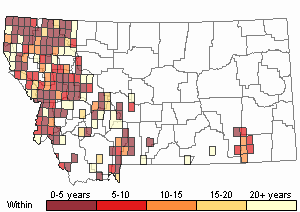
SUMMER (Feb 16 - Dec 14)
Direct Evidence of Breeding

Indirect Evidence of Breeding

No Evidence of Breeding

WINTER (Dec 15 - Feb 15)
Regularly Observed

Not Regularly Observed

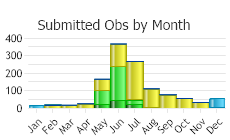
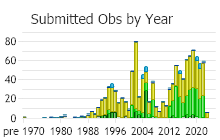
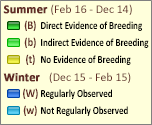 (Observations spanning multiple months or years are excluded from time charts)
(Observations spanning multiple months or years are excluded from time charts)
Migration
Black-backed Woodpeckers are a resident species in Montana, where their breeding range encompasses their year-round range. Black-backed Woodpeckers have been observed during every month of the year, although this species has been observed infrequently in the winter, which is probably due to the lack of observers during these months. Also, non-breeding season observations are almost always located in the same areas of the state where breeding and potential breeding records have been documented (Montana Bird Distribution Committee 2012). This indicates the species does not normally move outside of its usual breeding range during the winter.
Habitat
The habitat of Black-backed Woodpeckers in Montana is early successional, burned forest of mixed conifer, lodgepole pine, Douglas-fir, and spruce-fir (Hutto 1995a, 1995b), although they are more numerous in lower elevation Douglas-fir and pine forest habitats than in higher elevation subalpine spruce forest habitats (Bock and Bock 1974). This is supported by Harris (1982) who found Black-backed Woodpeckers in two recently burned forests comprised of 73% and 77% Douglas-fir, respectively. They appear to concentrate in recently burned forests and remain for several years (3 to 5) before leaving due to prey source decline (Harris 1982). In northwestern Montana, Black-backed Woodpeckers nested in areas of western larch (Larix occidentalis)/Douglas-fir forest with a major component of old-growth (McClelland et al. 1979). Harris (1982) found Black-backed Woodpeckers nesting within western larch even though the stand was predominately Douglas-fir. McClelland et al. (1979) determined the decay of heartwood while maintaining a hard outer shell of western larch creates an ideal nesting site for Black-backed Woodpeckers to excavate.
National Vegetation Classification System Groups Associated with this Species
Forest and Woodland
Low Elevation - Xeric Forest and Woodland
Montane - Subalpine Forest and Woodland
Wetland and Riparian
Riparian and Wetland Forest
Recently Disturbed or Modified
Insect-Killed Forest
Recently Burned
Food Habits
The bulk of the diet of Black-backed Woodpeckers is wood-boring beetle larvae (including Monochamus spp. and Dendroctonus spp.), but they also feed on other insects (e.g., weevils, beetles, spiders, ants). Occasionally they will eat fruits, nuts, sap, and cambium (Wickman 1965, Baldwin 1960, Short 1974, Scott et al. 1977, Terres 1980). Black-backed Woodpeckers may be attracted by the clearly audible chewings of wood-boring insects in recent burns (Taylor and Barmore 1980).
Black-backed Woodpeckers obtain food by flaking bark from trees (usually dead conifers) and logs, sometimes by picking and gleaning. They feed primarily on logs and low on large-diameter tree trunks (more than 7.5 centimeter diameter at breast height; but most often 15-25 centimeter dbh) (Short 1974, Villard 1994). Harris (1982) found that females foraged higher on trees than males. Females feed young more often than males, but carry less food in each visit. Although males visit less often they come with more food, and perhaps supply 50 percent to 75 percent of food to nestlings (Short 1974, Kilham 1983).
Ecology
Foraging in western Montana was primarily by pecking, with scaling the next most common technique (Harris 1982); most feeding was by scaling in Oregon (Bull et al. 1986). Harris (1982) found males foraged lower on the tree than females. Harris (1982) compares the ecology of Black-backed, Three-toed, and Hairy Woodpeckers. Size of the home ranges of 3 indivuals in Oregon was 178, 307, and 810 acres; home range size varied inversely to proportion of unlogged and mature/old-growth habitat (Goggans et al. 1989). They maintain intraspecific territories, but have overlapping home ranges with other woodpecker species (Goggans et al. 1989).
In general, Black-backed Woodpeckers are intraspecifically territorial. In Oregon, the home range size for three individuals was 72, 124, and 328 hectares; small home range size was associated with abundant mature/old-growth timber (Goggans et al. 1989). In the Sierra Nevada Range in California, densities were estimated at 0.2 pair per 40 hectares (Raphael and White 1984). In northeastern and north-central forests, territory size is estimated at 30 hectares and the maximum density is 3.3 pairs per 100 hectares (Evans and Conner 1979). In Idaho, the home range of one male in the breeding season was 72 hectares (Dixon and Saab 2000). In Vermont, the home range size was reported to be 61 hectares (Lisi 1988).
Black-backed Woodpeckers are highly responsive to forest fire and other processes, such as spruce budworm outbreaks, resulting in high concentrations of wood-boring insects invading dead trees. Local and regional irruptions and range extensions have been observed in response to burns and wood-borer outbreaks (West and Spiers 1959, Bock and Bock 1974, Kingery 1977, Yunick 1985).
Reproductive Characteristics
Very little information regarding Black-backed Woodpecker reproduction is currently available for Montana, as few nesting studies have been completed. Information gathered from other sources likely relevant to reproduction of Black-backed Woodpeckers in Montana state that they nest in late spring and early summer. Pair bonding and courtship begin in April and nest excavation begins in early May (Goggans 1989, Nova Scotia Museum of Natural History 1999). Clutch size is two to six (usually four). Incubation, by both sexes, may last 12 to 14 days. Young are altricial, tended by both parents and fledge in about 25 days (Ehrlich et al. 1988). In Oregon, the success rate for 19 nests was 63 percent (Goggans et al. 1989).
Management
No known active management is ongoing for Black-backed Woodpeckers in the state. However, studies from the western United States on the logging of post-fire trees indicated the negative impacts of this activity on Black-backed Woodpeckers (Kotliar et al. 2002). The conclusion reached was that this species rarely used even partially logged post-fire forests. Therefore, when salvage logging is planned, a delay of work for at least five years after the disturbance event is very important (Hutto 1995, Dixon and Saab 2000). This time delay is essential to provide habitat as the woodpecker's main prey items (wood-boring beetles) become less abundant after this period (Caton 1996). Salvage operations should retain more than 104 to 123 snags per hectare (more than 42 to 50 snags per acre) that are more than 23 cm diameter at breast height (dbh), more than 9 inches dbh (Dixon and Saab 2000, Wisdom et al. 2000).
Stewardship Responsibility
References
- Literature Cited AboveLegend:
 View Online Publication
View Online Publication Baldwin, P. H. 1960. Overwintering of woodpeckers in bark-beetle-infested spruce-fir forests of Colorado. Proceedings, 12th international ornithological congress. 12(1):71-84. Helsinki.
Baldwin, P. H. 1960. Overwintering of woodpeckers in bark-beetle-infested spruce-fir forests of Colorado. Proceedings, 12th international ornithological congress. 12(1):71-84. Helsinki. Bock, C. E. and J. H. Bock. 1974. On the geographical ecology and evolution of the three-toed woodpeckers, Picoides tridactylus and P. arcticus. American Midland Naturalist 92(2):397-405.
Bock, C. E. and J. H. Bock. 1974. On the geographical ecology and evolution of the three-toed woodpeckers, Picoides tridactylus and P. arcticus. American Midland Naturalist 92(2):397-405. Bull, E. L., S. R. Peterson, and J. W. Thomas. 1986. Resource partitioning among woodpeckers in northeastern Oregon. USDA Forest Service, Pacific Northwest Research Station, Portland, OR. Research Note PNW-444. 19 pp.
Bull, E. L., S. R. Peterson, and J. W. Thomas. 1986. Resource partitioning among woodpeckers in northeastern Oregon. USDA Forest Service, Pacific Northwest Research Station, Portland, OR. Research Note PNW-444. 19 pp. Caton, E. M. 1996. Effects of fire and salvage logging on the cavity-nesting bird community in northwestern Montana. Ph.D. dissertation, University of Montana, Missoula, MT. 115 pp.
Caton, E. M. 1996. Effects of fire and salvage logging on the cavity-nesting bird community in northwestern Montana. Ph.D. dissertation, University of Montana, Missoula, MT. 115 pp. Ehrlich, P., D. Dobkin, and D. Wheye. 1988. The birder’s handbook: a field guide to the natural history of North American birds. Simon and Schuster Inc. New York. 785 pp.
Ehrlich, P., D. Dobkin, and D. Wheye. 1988. The birder’s handbook: a field guide to the natural history of North American birds. Simon and Schuster Inc. New York. 785 pp. Evans, K. E. and R. N. Conner. 1979. Snag management. In: R. M. DeGraff and K. E. Evans, eds. Management of North Central and Northeastern Forests for Nongame birds. US Forest Service Technical Report NC-51.
Evans, K. E. and R. N. Conner. 1979. Snag management. In: R. M. DeGraff and K. E. Evans, eds. Management of North Central and Northeastern Forests for Nongame birds. US Forest Service Technical Report NC-51. Farrand, J., ed. 1983. Audubon Society master guide to birding, 3 volumes. Alfred A. Knopf, New York. 1244 pp.
Farrand, J., ed. 1983. Audubon Society master guide to birding, 3 volumes. Alfred A. Knopf, New York. 1244 pp. Goggans, R. 1989. Black-backed woodpecker. In: Clark, T. W., A. H. Harvey, R. D. Dorn, D. L. Genter, and C. Groves, eds. Rare, sensitive and threatened species of the Greater Yellowstone ecosystem. pp. 88-89. Northern Rockies Conservation Cooperative, Montana Natural Heritage Program, The Nature Conservancy and Mountain West Environmental Services. 153 pp.
Goggans, R. 1989. Black-backed woodpecker. In: Clark, T. W., A. H. Harvey, R. D. Dorn, D. L. Genter, and C. Groves, eds. Rare, sensitive and threatened species of the Greater Yellowstone ecosystem. pp. 88-89. Northern Rockies Conservation Cooperative, Montana Natural Heritage Program, The Nature Conservancy and Mountain West Environmental Services. 153 pp. Goggans, R., R.D. Dixon and L.C. Seminara. 1989. Habitat use by three-toed and black-backed woodpeckers, Deschutes National Forest, Oregon. Oregon Department of Fish and Wildlife, Nongame Wildlife Program. USDA Deschutes National Forest Technical Report 87-3-02. 43 pp.
Goggans, R., R.D. Dixon and L.C. Seminara. 1989. Habitat use by three-toed and black-backed woodpeckers, Deschutes National Forest, Oregon. Oregon Department of Fish and Wildlife, Nongame Wildlife Program. USDA Deschutes National Forest Technical Report 87-3-02. 43 pp. Harris, M. A. 1982. Habitat use among woodpeckers in forest burns. M.S. Thesis. University of Montana, Missoula. 62 pp.
Harris, M. A. 1982. Habitat use among woodpeckers in forest burns. M.S. Thesis. University of Montana, Missoula. 62 pp. Hutto, R. L. 1995. USFS Northern Region Songbird Monitoring Program - distribution and habitat relationships. Second Report, USFS Region 1 contract #57-0343-5-00012. 120 pp.
Hutto, R. L. 1995. USFS Northern Region Songbird Monitoring Program - distribution and habitat relationships. Second Report, USFS Region 1 contract #57-0343-5-00012. 120 pp. Kilham, L. 1966. Nesting activities of black-backed woodpeckers. Condor 68:308-310.
Kilham, L. 1966. Nesting activities of black-backed woodpeckers. Condor 68:308-310. Kilham, L. 1983. Life history studies of woodpeckers of eastern North America. Nuttall Ornithological Club Publication Number 20. vii + 240 pp.
Kilham, L. 1983. Life history studies of woodpeckers of eastern North America. Nuttall Ornithological Club Publication Number 20. vii + 240 pp. Kingery, H.E. 1977. The autumn migration, August 1- November 30, 1976: mountain west region. American Birds 31:203-207.
Kingery, H.E. 1977. The autumn migration, August 1- November 30, 1976: mountain west region. American Birds 31:203-207. Kotliar, N. B., S. Heil, R. L. Hutto, V. A. Saab, C. P. Melcher, and M. E. McFadzen. 2002. Effects of fire and post-fire salvage logging on avian communities in conifer-dominated forests of the western United States. Studies in Avian Biology 25:49-64.
Kotliar, N. B., S. Heil, R. L. Hutto, V. A. Saab, C. P. Melcher, and M. E. McFadzen. 2002. Effects of fire and post-fire salvage logging on avian communities in conifer-dominated forests of the western United States. Studies in Avian Biology 25:49-64. Lisi, G. 1988. A field study of black-backed woodpeckers in Vermont. Vermont Fish and Wildlife Department, Nongame and Endangered Species Program, Technical Report 3.
Lisi, G. 1988. A field study of black-backed woodpeckers in Vermont. Vermont Fish and Wildlife Department, Nongame and Endangered Species Program, Technical Report 3. Marks, J.S., P. Hendricks, and D. Casey. 2016. Birds of Montana. Arrington, VA. Buteo Books. 659 pages.
Marks, J.S., P. Hendricks, and D. Casey. 2016. Birds of Montana. Arrington, VA. Buteo Books. 659 pages. McClelland, B.R., S.S. Frissel, W.C. Fischer, and C.H. Halvorson. 1979. Habitat management for hole-nesting birds in forests of western larch and Douglas-fir. Journal of Forestry 77(8):480-483.
McClelland, B.R., S.S. Frissel, W.C. Fischer, and C.H. Halvorson. 1979. Habitat management for hole-nesting birds in forests of western larch and Douglas-fir. Journal of Forestry 77(8):480-483. Montana Bird Distribution Committee. 2012. P.D. Skaar's Montana bird distribution. 7th Edition. Montana Audubon, Helena, Montana. 208 pp. + foldout map.
Montana Bird Distribution Committee. 2012. P.D. Skaar's Montana bird distribution. 7th Edition. Montana Audubon, Helena, Montana. 208 pp. + foldout map. Nova Scotia Museum of Natural History. 1999. Birds of Nova Scotia: black-backed woodpecker.
Nova Scotia Museum of Natural History. 1999. Birds of Nova Scotia: black-backed woodpecker. Raphael, M.G. and M. White. 1984. Use of snags by cavity-nesting birds in the Sierra Nevada. Wildlife Monographs 86:1-66.
Raphael, M.G. and M. White. 1984. Use of snags by cavity-nesting birds in the Sierra Nevada. Wildlife Monographs 86:1-66. Scott, V.E., K.E. Evans, D.R. Patton, and C.P. Stone. 1977. Cavity-nesting birds of North American forests. U.S. Forest Service Agriculture Handbook 511. 112 pp.
Scott, V.E., K.E. Evans, D.R. Patton, and C.P. Stone. 1977. Cavity-nesting birds of North American forests. U.S. Forest Service Agriculture Handbook 511. 112 pp. Taylor, D.L. and W.J. Barmore, Jr. 1980. Post-fire succession of avifauna in coniferous forest of Yellowstone and Grand Teton National Parks, Wyoming. In: Management of Western Forests and Grasslands for non-game birds. pp. 130-145. U.S. Forest Service General Technical Report INT-86.
Taylor, D.L. and W.J. Barmore, Jr. 1980. Post-fire succession of avifauna in coniferous forest of Yellowstone and Grand Teton National Parks, Wyoming. In: Management of Western Forests and Grasslands for non-game birds. pp. 130-145. U.S. Forest Service General Technical Report INT-86. Terres, J.K. 1980. The Audubon Society encyclopedia of North American birds. Alfred A. Knopf, New York. 1109 pp.
Terres, J.K. 1980. The Audubon Society encyclopedia of North American birds. Alfred A. Knopf, New York. 1109 pp. Villard, P. 1994. Foraging behavior of black-backed and three-toed woodpeckers during spring and summer in a Canadian boreal forest. Canadian Journal of Zoology 72:1957-1959.
Villard, P. 1994. Foraging behavior of black-backed and three-toed woodpeckers during spring and summer in a Canadian boreal forest. Canadian Journal of Zoology 72:1957-1959. West, J. D. and J. Murray Spiers. 1959. The 1956-1957 invasion of three-toed woodpeckers. Wilson Bulletin 71:348-363.
West, J. D. and J. Murray Spiers. 1959. The 1956-1957 invasion of three-toed woodpeckers. Wilson Bulletin 71:348-363. Wickman, B. E. 1965. Black-backed three-toed woodpecker, Picoides arcticus, predation on Monochamus oregonensis. Pan-Pacific Entomologist 41(3)162-164.
Wickman, B. E. 1965. Black-backed three-toed woodpecker, Picoides arcticus, predation on Monochamus oregonensis. Pan-Pacific Entomologist 41(3)162-164. Wisdom, M. J., R. S. Holthausen, B. C. Wales, C. D. Hargis, V. A. Saab, D. C. Lee, W. J. Hann, T. D. Rich, M. M. Rowland, W. J. Murphy, and M. R. Eames. 2000. Source habitats for terrestrial vertebrates of focus in the Interior Columbia Basin: broad-scale trends and management implications. Volume 1 - Overview, Volume 2 - Group Level Results, Volume 3 - Appendices. General Technical Report PNW-GTR-485. USDA Forest.
Wisdom, M. J., R. S. Holthausen, B. C. Wales, C. D. Hargis, V. A. Saab, D. C. Lee, W. J. Hann, T. D. Rich, M. M. Rowland, W. J. Murphy, and M. R. Eames. 2000. Source habitats for terrestrial vertebrates of focus in the Interior Columbia Basin: broad-scale trends and management implications. Volume 1 - Overview, Volume 2 - Group Level Results, Volume 3 - Appendices. General Technical Report PNW-GTR-485. USDA Forest. Yunick, R.P. 1985. A review of recent irruptions of the black-backed woodpecker and three-toed woodpecker in eastern North America. Journal of Field Ornithology 56(2):138-152.
Yunick, R.P. 1985. A review of recent irruptions of the black-backed woodpecker and three-toed woodpecker in eastern North America. Journal of Field Ornithology 56(2):138-152.
- Additional ReferencesLegend:
 View Online Publication
View Online Publication
Do you know of a citation we're missing? American Ornithologists Union. 1983. Checklist of North American birds, 6th Edition. 877 PP.
American Ornithologists Union. 1983. Checklist of North American birds, 6th Edition. 877 PP. American Ornithologists’ Union [AOU]. 1998. Check-list of North American birds, 7th edition. American Ornithologists’ Union, Washington, D.C. 829 p.
American Ornithologists’ Union [AOU]. 1998. Check-list of North American birds, 7th edition. American Ornithologists’ Union, Washington, D.C. 829 p. Anonymous. 1992. Survey techniques to monitor three-toed and black-backed woodpeckers. Workshop on Monitoring Cavity-Nesters, February 24-25, 1992. Sponsored by The Wildlife Society, Oregon Chapter. 9 pp.
Anonymous. 1992. Survey techniques to monitor three-toed and black-backed woodpeckers. Workshop on Monitoring Cavity-Nesters, February 24-25, 1992. Sponsored by The Wildlife Society, Oregon Chapter. 9 pp. Apfelbaum, S., and A. Haney. 1981. Bird populations before and after wild fire in a Great Lakes USA pine forest. Condor 83(4):347-354.
Apfelbaum, S., and A. Haney. 1981. Bird populations before and after wild fire in a Great Lakes USA pine forest. Condor 83(4):347-354. Bailey, V. and F.M. Bailey. 1918. Wild animals of Glacier National Park: the mammals, with notes on physiography and life zones, and the birds. U.S. Department of the Interior, National Park Service. 210 p.
Bailey, V. and F.M. Bailey. 1918. Wild animals of Glacier National Park: the mammals, with notes on physiography and life zones, and the birds. U.S. Department of the Interior, National Park Service. 210 p. Blackford, J. L. 1955. Woodpecker concentration in burned forest. Condor 57:28-30.
Blackford, J. L. 1955. Woodpecker concentration in burned forest. Condor 57:28-30. Campbell, R.W., N.K. Dawe, I. McTaggart-Cowan, J.M. Cooper, G.W. Kaiser, M.C.E. McNall. 1990. The Birds of British Columbia. Vol. 2. Canadian Wildlife Service and the Royal British Columbia Museum and Environment Canada.
Campbell, R.W., N.K. Dawe, I. McTaggart-Cowan, J.M. Cooper, G.W. Kaiser, M.C.E. McNall. 1990. The Birds of British Columbia. Vol. 2. Canadian Wildlife Service and the Royal British Columbia Museum and Environment Canada. Casey, D. 2000. Partners in Flight Draft Bird Conservation Plan Montana. Version 1.0. 287 pp.
Casey, D. 2000. Partners in Flight Draft Bird Conservation Plan Montana. Version 1.0. 287 pp. Darveau, M., P. Beauchesene, L. Belanger, J. Huot, and P. Larue. 1995. Riparian forest strips as habitat for breeding birds in boreal forest. Journal of Wildlife Management 59 (1):67-78.
Darveau, M., P. Beauchesene, L. Belanger, J. Huot, and P. Larue. 1995. Riparian forest strips as habitat for breeding birds in boreal forest. Journal of Wildlife Management 59 (1):67-78. Dickson, D. C. 1994. Systematic wildlife observations on the Blackfoot-Clearwater Wildlife Management Area. Montana Department of Fish, Wildlife, and Parks. Missoula, Montana. 12 pp. plus appendices.
Dickson, D. C. 1994. Systematic wildlife observations on the Blackfoot-Clearwater Wildlife Management Area. Montana Department of Fish, Wildlife, and Parks. Missoula, Montana. 12 pp. plus appendices. Dixon, R.D. and V.A. Saab. 2000. Black-backed Woodpecker (Picoides arcticus). Species Account Number 509. The Birds of North America Online (A. Poole, Ed.). Ithaca, NY: Cornell Laboratory of Ornithology; Retrieved 3/25/2008 from The Birds of North America Online database
Dixon, R.D. and V.A. Saab. 2000. Black-backed Woodpecker (Picoides arcticus). Species Account Number 509. The Birds of North America Online (A. Poole, Ed.). Ithaca, NY: Cornell Laboratory of Ornithology; Retrieved 3/25/2008 from The Birds of North America Online database Ehrlich, P.R., D.S. Dobkin, and D. Wheye. 1988. The birder's handbook: a field guide to the natural history of North American birds. Simon and Shuster, Inc., New York. xxx + 785 pp.
Ehrlich, P.R., D.S. Dobkin, and D. Wheye. 1988. The birder's handbook: a field guide to the natural history of North American birds. Simon and Shuster, Inc., New York. xxx + 785 pp. Environment Canada. 1997. Sustaining Canada's Forests: Timber Harvesting. National Environmental Indicator Series, SOE Bulletin No. 95-4.
Environment Canada. 1997. Sustaining Canada's Forests: Timber Harvesting. National Environmental Indicator Series, SOE Bulletin No. 95-4. Goggans, Rebecca, Rita D. Dixon and L. Claire Seminara. 1987. Habitat use by three-toed and black-backed woodpeckers, Deschutes National Forest, Oregon. Final Report, Oregon Department of Fish and Wildlife. 50pp.
Goggans, Rebecca, Rita D. Dixon and L. Claire Seminara. 1987. Habitat use by three-toed and black-backed woodpeckers, Deschutes National Forest, Oregon. Final Report, Oregon Department of Fish and Wildlife. 50pp. Hays, R., R.L. Eng, and C.V. Davis (preparers). 1984. A list of Montana birds. Helena, MT: MT Dept. of Fish, Wildlife & Parks.
Hays, R., R.L. Eng, and C.V. Davis (preparers). 1984. A list of Montana birds. Helena, MT: MT Dept. of Fish, Wildlife & Parks. Hejl, S.J., R.L. Hutto, C.R. Preston, and D.M. Finch. 1995. The effects of silvicultural treatments on forest birds in the Rocky Mountains. pp. 220-244 In: T.E. Martin and D.M. Finch (eds). Ecology and Management of Neotropical Migratory Birds. New York, NY: Oxford Univ. Press. 489 p.
Hejl, S.J., R.L. Hutto, C.R. Preston, and D.M. Finch. 1995. The effects of silvicultural treatments on forest birds in the Rocky Mountains. pp. 220-244 In: T.E. Martin and D.M. Finch (eds). Ecology and Management of Neotropical Migratory Birds. New York, NY: Oxford Univ. Press. 489 p. Hitchcox, S.M. 1996. Abundance and nesting success of cavity nesting birds in unlogged and salvage logged burned forest in northwestern Montana. Thesis. Missoula, MT: University of Montana. 89 p.
Hitchcox, S.M. 1996. Abundance and nesting success of cavity nesting birds in unlogged and salvage logged burned forest in northwestern Montana. Thesis. Missoula, MT: University of Montana. 89 p. Hoffland, John Robert. 1995. A comparison of bird abundance among selectively logged old-growth and mature second-growth Ponderosa Pine. M.S. Thesis. University of Montana. Missoula, MT.
Hoffland, John Robert. 1995. A comparison of bird abundance among selectively logged old-growth and mature second-growth Ponderosa Pine. M.S. Thesis. University of Montana. Missoula, MT. Hoffman, N.J. 1997. Distribution of Picoides woodpeckers in relation to habitat disturbance within the Yellowstone area. M.Sc. Thesis. Bozeman, MT: Montana State University. 74 p.
Hoffman, N.J. 1997. Distribution of Picoides woodpeckers in relation to habitat disturbance within the Yellowstone area. M.Sc. Thesis. Bozeman, MT: Montana State University. 74 p. Hutto, Richard L. 1995. Composition of Bird Communities Following Stand-Replacement Fires in Northern Rocky Mountain (U.S.A.) Conifer Forests. Conservation Biology. 9 (5): 1041-1058.
Hutto, Richard L. 1995. Composition of Bird Communities Following Stand-Replacement Fires in Northern Rocky Mountain (U.S.A.) Conifer Forests. Conservation Biology. 9 (5): 1041-1058. Johnsgard, P.A. 1992. Birds of the Rocky Mountains with particular reference to national parks in the northern Rocky Mountain region. Lincoln: University of Nebraska Press. xi + 504 pp.
Johnsgard, P.A. 1992. Birds of the Rocky Mountains with particular reference to national parks in the northern Rocky Mountain region. Lincoln: University of Nebraska Press. xi + 504 pp. Joslin, Gayle, and Heidi B. Youmans. 1999. Effects of recreation on Rocky Mountain wildlife: a review for Montana. [Montana]: Montana Chapter of the Wildlife Society.
Joslin, Gayle, and Heidi B. Youmans. 1999. Effects of recreation on Rocky Mountain wildlife: a review for Montana. [Montana]: Montana Chapter of the Wildlife Society. Lenard, S., J. Carlson, J. Ellis, C. Jones, and C. Tilly. 2003. P. D. Skaar's Montana bird distribution, 6th edition. Montana Audubon, Helena, MT. 144 pp.
Lenard, S., J. Carlson, J. Ellis, C. Jones, and C. Tilly. 2003. P. D. Skaar's Montana bird distribution, 6th edition. Montana Audubon, Helena, MT. 144 pp. Lester, A.N. 1980. Numerical response of woodpeckers and their effect on mortality of mountain pine beetles in lodgepole pine in northwestern Montana. M.S. thesis. University of Montana, Missoula. 103 pp.
Lester, A.N. 1980. Numerical response of woodpeckers and their effect on mortality of mountain pine beetles in lodgepole pine in northwestern Montana. M.S. thesis. University of Montana, Missoula. 103 pp. Marshall, D. B. 1992. Status of the black-backed woodpecker in Oregon and Washington. Audubon Society of Portland, OR. 15 pp.
Marshall, D. B. 1992. Status of the black-backed woodpecker in Oregon and Washington. Audubon Society of Portland, OR. 15 pp. Maxell, B.A. 2016. Northern Goshawk surveys on the Beartooth, Ashland, and Sioux Districts of the Custer-Gallatin National Forest: 2012-2014. Montana Natural Heritage Program. Helena, MT. 114pp.
Maxell, B.A. 2016. Northern Goshawk surveys on the Beartooth, Ashland, and Sioux Districts of the Custer-Gallatin National Forest: 2012-2014. Montana Natural Heritage Program. Helena, MT. 114pp. McClelland, B. R. 1977. Relationships between hole-nesting birds, forest snags and decay in western larch-Douglas fir forests of the northern Rocky Mountains. Ph.D. Thesis., Univ. of Montana, Missoula. 483 pp.
McClelland, B. R. 1977. Relationships between hole-nesting birds, forest snags and decay in western larch-Douglas fir forests of the northern Rocky Mountains. Ph.D. Thesis., Univ. of Montana, Missoula. 483 pp. MT Fish, Wildlife & Parks. No date. Blackfoot-Clearwater Wildlife Management Area checklist.
MT Fish, Wildlife & Parks. No date. Blackfoot-Clearwater Wildlife Management Area checklist. Multiple Authors. 1992. Abstracts from Montana Rare Animal Meeting. Lewistown, MT. November 5-6, 1992. 20 p.
Multiple Authors. 1992. Abstracts from Montana Rare Animal Meeting. Lewistown, MT. November 5-6, 1992. 20 p. Oechsli, L.M. 2000. Ex-urban development in the Rocky Mountain West: consequences for native vegetation, wildlife diversity, and land-use planning in Big Sky, Montana. M.Sc. Thesis. Montana State University, Bozeman. 73 p.
Oechsli, L.M. 2000. Ex-urban development in the Rocky Mountain West: consequences for native vegetation, wildlife diversity, and land-use planning in Big Sky, Montana. M.Sc. Thesis. Montana State University, Bozeman. 73 p. Pierson, J. C. 2009. Genetic population structure and dispersal of two North American woodpeckers in ephemeral habitats. Ph.D. dissertation, University of Montana, Missoula.
Pierson, J. C. 2009. Genetic population structure and dispersal of two North American woodpeckers in ephemeral habitats. Ph.D. dissertation, University of Montana, Missoula. Powell, H.D.W. 2000. The influence of prey density on post-fire habitat use of the Black-backed Woodpecker. MS Thesis 6903, University of Montana, Missoula.
Powell, H.D.W. 2000. The influence of prey density on post-fire habitat use of the Black-backed Woodpecker. MS Thesis 6903, University of Montana, Missoula. Ralph, J.C., J.R. Sauer, and S. Droege. 1995. Monitoring bird populations by point counts. Gen. Tech. Rep. PSW-GTR-149. Albany, CA: USDA Pacific Southwest Research Station. 181 p.
Ralph, J.C., J.R. Sauer, and S. Droege. 1995. Monitoring bird populations by point counts. Gen. Tech. Rep. PSW-GTR-149. Albany, CA: USDA Pacific Southwest Research Station. 181 p. Raphael, M.G., M.L. Morrison, and M.P. Yoder-Williams. 1987. Breeding bird populations during twenty-five years of postfire succession in the Sierra Nevada. Condor 89: 614-626.
Raphael, M.G., M.L. Morrison, and M.P. Yoder-Williams. 1987. Breeding bird populations during twenty-five years of postfire succession in the Sierra Nevada. Condor 89: 614-626. Reed, J. M. 1995. Relative vulnerability to extirpation of montane breeding birds in the Great Basin. Great Basin Naturalist 55:342-351.
Reed, J. M. 1995. Relative vulnerability to extirpation of montane breeding birds in the Great Basin. Great Basin Naturalist 55:342-351. Reichel, J.D., D.L. Genter and E. Atkinson. 1992. Sensitive animal species in the Elkhorn and Big Belt Mountains of the Helena National Forest. Unpublished report to the Helena National Forest. Montana Natural Heritage Program, Helena. 158 p.
Reichel, J.D., D.L. Genter and E. Atkinson. 1992. Sensitive animal species in the Elkhorn and Big Belt Mountains of the Helena National Forest. Unpublished report to the Helena National Forest. Montana Natural Heritage Program, Helena. 158 p. Saab, V. A. and J. G. Dudley. 1998. Responses of cavity-nesting birds to stand-replacement fore and salvage logging in ponderosa pine/Douglas-fir forests of southwestern Idaho. USDA Forest Service Rocky Mountains Research Station Research Paper RMRS-RP-11, Ogden, ID.
Saab, V. A. and J. G. Dudley. 1998. Responses of cavity-nesting birds to stand-replacement fore and salvage logging in ponderosa pine/Douglas-fir forests of southwestern Idaho. USDA Forest Service Rocky Mountains Research Station Research Paper RMRS-RP-11, Ogden, ID. Saunders, A.A. 1914. The birds of Teton and northern Lewis & Clark counties, Montana. Condor 16:124-144.
Saunders, A.A. 1914. The birds of Teton and northern Lewis & Clark counties, Montana. Condor 16:124-144. Short, L. L. 1982. Woodpeckers of the World. Museum of Natural History [Greenville, Delaware], Monograph Series xviii + 676 pp.
Short, L. L. 1982. Woodpeckers of the World. Museum of Natural History [Greenville, Delaware], Monograph Series xviii + 676 pp. Short, L.L. 1974. Habits and interactions of North American Three-toed Woodpeckers (Picoides arcticus and Picoides tridactylus). American Museum Novitiates. 2547:1-42.
Short, L.L. 1974. Habits and interactions of North American Three-toed Woodpeckers (Picoides arcticus and Picoides tridactylus). American Museum Novitiates. 2547:1-42. Sibley, D. 2014. The Sibley guide to birds. Alfred A. Knopf, New York, NY. 598 pp.
Sibley, D. 2014. The Sibley guide to birds. Alfred A. Knopf, New York, NY. 598 pp. Silloway, P. M. 1901. Summer birds of Flathead Lake. Bulletin of the University of Montana No. 3, Biological Series No. 1. 83 pp.
Silloway, P. M. 1901. Summer birds of Flathead Lake. Bulletin of the University of Montana No. 3, Biological Series No. 1. 83 pp. Skaar, P. D., D. L. Flath, and L. S. Thompson. 1985. Montana bird distribution. Montana Academy of Sciences Monograph 3(44): ii-69.
Skaar, P. D., D. L. Flath, and L. S. Thompson. 1985. Montana bird distribution. Montana Academy of Sciences Monograph 3(44): ii-69. Skaar, P.D. 1969. Birds of the Bozeman latilong: a compilation of data concerning the birds which occur between 45 and 46 N. latitude and 111 and 112 W. longitude, with current lists for Idaho, Montana, Wyoming, impinging Montana counties and Yellowstone National Park. Bozeman, MT. 132 p.
Skaar, P.D. 1969. Birds of the Bozeman latilong: a compilation of data concerning the birds which occur between 45 and 46 N. latitude and 111 and 112 W. longitude, with current lists for Idaho, Montana, Wyoming, impinging Montana counties and Yellowstone National Park. Bozeman, MT. 132 p. Smucker, Kristina M. 2003. Changes in bird abundance and species composition in a coniferous forest following mixed-severity wildfire. M.S. Thesis. University of Montana. Missoula, MT.
Smucker, Kristina M. 2003. Changes in bird abundance and species composition in a coniferous forest following mixed-severity wildfire. M.S. Thesis. University of Montana. Missoula, MT. Stohlgren, T. J. 1998. Rocky Mountains. Pp. 473-504 in M. J. Mac, P. A. Opler, C. E. Puckett Haecker, and P. D. Doran. Status and Trends of the Nation's Biological Resources. USDI U.S. Geological Survey, Washington, D.C.
Stohlgren, T. J. 1998. Rocky Mountains. Pp. 473-504 in M. J. Mac, P. A. Opler, C. E. Puckett Haecker, and P. D. Doran. Status and Trends of the Nation's Biological Resources. USDI U.S. Geological Survey, Washington, D.C. Thompson, Richard W., Western Resource Dev. Corp., Boulder, CO., 1996, Wildlife baseline report for the Montana [Montanore] Project, Lincoln and Sanders counties, Montana. In Application for a Hard Rock Operating Permit and Proposed Plan of Operation, Montanore Project, Lincoln and Sanders Counties, Montana. Vol. 5. Stroiazzo, John. Noranda Minerals Corp., Libby, MT. Revised September 1996.
Thompson, Richard W., Western Resource Dev. Corp., Boulder, CO., 1996, Wildlife baseline report for the Montana [Montanore] Project, Lincoln and Sanders counties, Montana. In Application for a Hard Rock Operating Permit and Proposed Plan of Operation, Montanore Project, Lincoln and Sanders Counties, Montana. Vol. 5. Stroiazzo, John. Noranda Minerals Corp., Libby, MT. Revised September 1996. U.S. Forest Service. 1991. Forest and rangeland birds of the United States: Natural history and habitat use. U.S. Department of Agriculture, Forest Service Agricultural Handbook 688. 625 pages.
U.S. Forest Service. 1991. Forest and rangeland birds of the United States: Natural history and habitat use. U.S. Department of Agriculture, Forest Service Agricultural Handbook 688. 625 pages. Villard, M. and J. Schieck. 1996. Immediate post-fire nesting by black-backed woodpeckers, Picoides arcticus, in Northern Alberta. Canadian Field-Naturalist 111:478-479.
Villard, M. and J. Schieck. 1996. Immediate post-fire nesting by black-backed woodpeckers, Picoides arcticus, in Northern Alberta. Canadian Field-Naturalist 111:478-479. Villard, P. and C. W. Benniger. 1993. Foraging behavior of male Black-backed and Hairy woodpeckers in a forest burn. Journal of Field Ornithology 64(1):71-76.
Villard, P. and C. W. Benniger. 1993. Foraging behavior of male Black-backed and Hairy woodpeckers in a forest burn. Journal of Field Ornithology 64(1):71-76. Weydemeyer, W., and D. Weydemeyer. 1928. The woodpeckers of Lincoln County, Montana. Condor 30:339-346.
Weydemeyer, W., and D. Weydemeyer. 1928. The woodpeckers of Lincoln County, Montana. Condor 30:339-346. Woolf, Jennifer C. 2003. Effects of thinning and prescribed burning on birds and small mammals. M.S. Thesis. University of Montana. Missoula, MT.
Woolf, Jennifer C. 2003. Effects of thinning and prescribed burning on birds and small mammals. M.S. Thesis. University of Montana. Missoula, MT.
- Web Search Engines for Articles on "Black-backed Woodpecker"
- Additional Sources of Information Related to "Birds"





